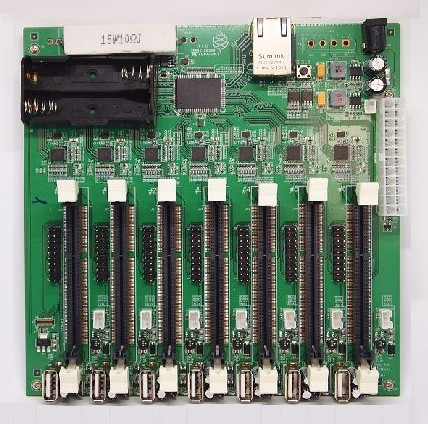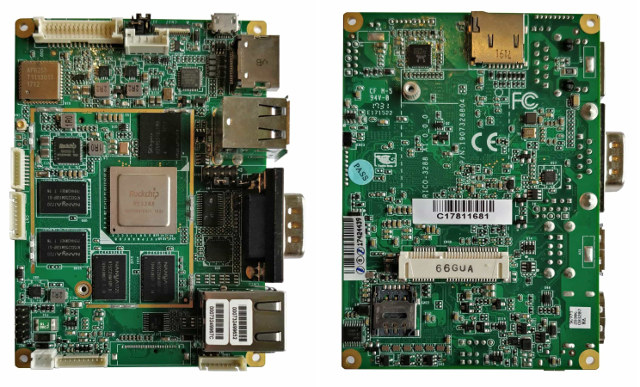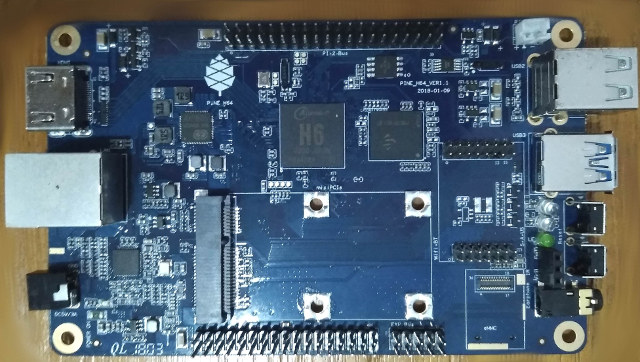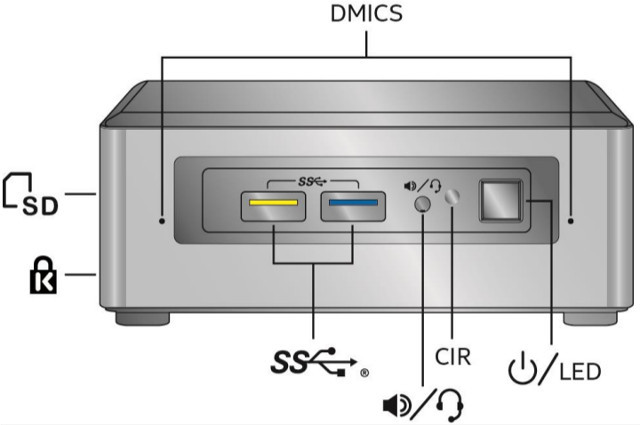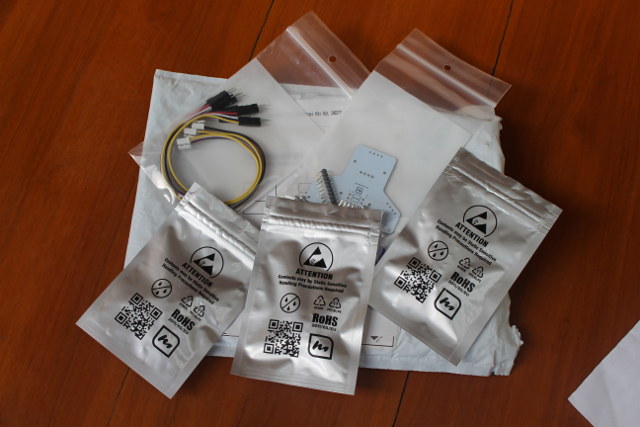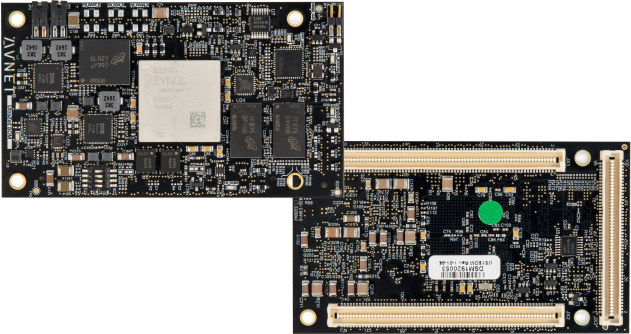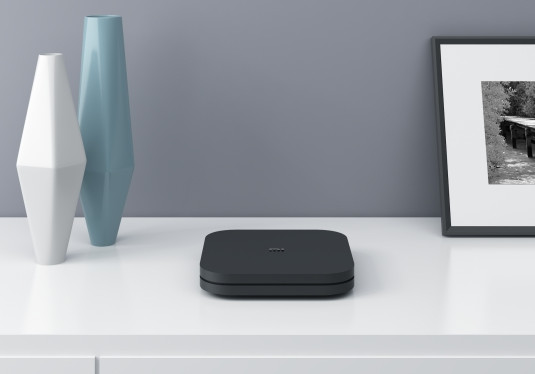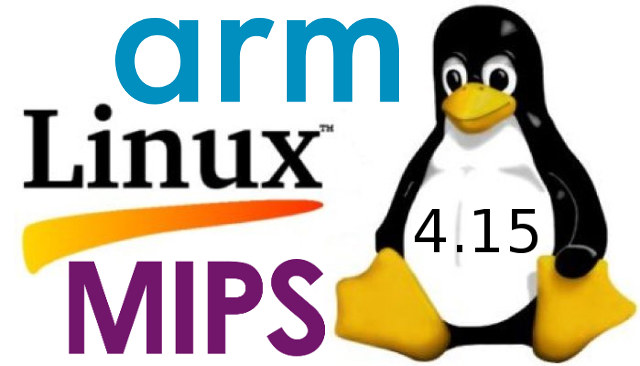We’ve previously reported Pine64 had developed “Sopine Clusterboard” for a specific project with support for up to seven SOPINE A64 SoMs powered by Allwinner A64 quad core Cortex A53 processor. At the time (August 2017), it was unclear whether the company would sell to the solution publicly, but they’ve now gone ahead and launched Pine64 ClusterBoard for $99.99 plus shipping, including one free SOPINE A64 module for a limited time. PINE64 ClusterBoard specifications: SoM Slots – 7x SO-DIMM slot for SOPINE A64 modules Connectivity 1x Gigabit Ethernet port (RJ45) All SoMs are connected via Gigabit Ethernet using 7x RTL8211E transceivers and RTL8370N network switch (See diagram below) USB – 7x USB 2.0 port, one per SoM Expansion – Headers for each SoM with UART (serial console), I2C, key ADC, GPIOs, SPI, RESET/POWER 5V and GND Misc – RTC, reset button, optional EEPROM connected to RTL8370N Power Supply 5V/15A via power barrel […]
Amarula Vyasa is a $150 Pico-ITX Single Board Computer Powered by Rockchip RK3288 SoC
Yesterday, as I published Linux 4.15 changelog for Arm and MIPS, I discovered a new Rockchip RK3288 platform described as “Amarula Vyasa single board computer”, so that got me interested. The full name of the company is “Amarula Electronics Limited Sony UK”, which means Vyasa is the name of the board. Amarula Vyasa relies on a 2.5″ Pico-ITX form factor, and is available in either commercial and wide temperature (WiTAS) range. The board is equipped with 2GB RAM, 16GB eMMC flash, exposes ports and connectors such as HDMI 2.0, eDP, and LVDS, and plenty of network connectivity (WiFi, Ethernet, mPCIe modem…) that would make it suitable for a connected digital signage, or other applications requiring a (touchscreen) display and redundant Internet / network connectivity. Amarula Vyasa specifications: SoC – CPU Rockchip RK3288 (ARM CortexTM -A17 Quad-core 1.6GHz) System Memory – 2GB DDR3L SDRAM Storage – 16GB eMMC flash, Micro SD […]
Pine H64 Development Board Features Allwinner H6 processor, Gigabit Ethernet, USB 3.0 and PCIe for $26 and Up
As expected, Pine64 has now launched Pine H64 development board, powered by Allwinner H6 quad core processor, and contrary to Orange Pi H6 boards, it exposes both Gigabit Ethernet, and a USB 3.0 port, which should please people wanting fast storage combined with Gigabit Ethernet. The board comes in three variants with 1, 2 or 3GB of memory, with all also equipped with a mini PCIe interface, and various I/O headers. Pine H64 specifications: SoC – Allwinner H6 quad core Cortex A53 processor with Arm Mali-T720MP2 GPU System Memory – 1, 2 or 3GB LPDDR3 PC-1600 RAM Storage – 128 Mbit SPI flash, micro SD card slot, and eMMC flash module connector (all bootable) Video Output – HDMI 2.0a up to 4K @ 60 Hz Audio – HDMI audio output, Video Decoding – 10-bit H.265 up to 4K @ 60 fps, VP9 and H.264 up to 4K @ 30 fps […]
Intel Gemini Lake NUC7CJY/NUC7PJY Kits and Mini PC Specifications Released
Based on Intel NUC 2018/2019 roadmap published, we expected the first Intel Gemini Lake NUC mini PC to launch right at the end of 2017, but there’s been some delays. Since then we’ve learned Gemini Lake mini PC from third parties should launch around the end of March / beginning of April, and the official Intel GLK NUCs might launch around that time frame, or maybe a little earlier, because today, I’ve been informed the specifications for NUC7CJY/NUC7PJY kits and mini PC had been released on Intel website. Both variants have basically the same specifications expect NUC7CJY comes with a Celeron processor, and NUC7PJY with a Pentium Silver processor: SoC Intel NUC Kit NUC7CJYH / Intel NUC Mini PC NUC7CJYS – Dual core Intel Celeron J4005 processor @ 2.0 GHz / 2.70 GHz (Turbo) with 4MB cache, Intel HD Graphics 600; up to 10 TDP Intel NUC NUC7PJYH – Quad […]
Getting Started with TinyLIDAR Time-of-Flight Sensor on Arduino and Raspberry Pi
TinyLIDAR is an inexpensive and compact board based on STMicro VL53L0X Time-of-Flight (ToF) ranging sensor that allows you to measure distance up to 2 meters using infrared signals, and with up to 60 Hz. Contrary to most other VL53L0X boards, it also includes an STM32L0 micro-controller that takes care of most of the processing, frees up resource on your host board (e.g. Arduino UNO), and should be easier to control thanks to I2C commands. The project was successfully funded on Indiegogo by close to 600 backers, and the company contacted me to provided a sample of the board, which I have now received, and tested with Arduino (Leonardo), and Raspberry Pi (2). TinyLIDAR Unboxing I was expecting a single board, but instead I received a bubble envelop with five small zipped packages. Opening them up revealed three TinyLIDAR boards, the corresponding Grove to jumper cables, and a bracket PCB for […]
UltraZed-EG SoM and Starter Kit Feature Xilinx Zynq UltraScale+ ZU3EG MPSoC
Xilinx Zynq UltraScale+ Arm Cortex A53 + FPGA MPSoCs were announced in 2015, with actual products launched in early 2017 such as AXIOM development board or Trenz Electronic TE0808 UltraSOM+ system-on-module which are based on the ZU9EG model, and cost several thousand dollars. Recently, I wrote about Mycroft Mark II smart speaker based on a “quad core Xilinx processor”, and initially I assumed it was an Zynq UltraScale+ MPSoCs since those are the only Xilinx “quad core processors” I know of, but now I think it must be an unannounced part, since the company can’t provide the exact part number, and the price would be too low. Nevertheless, this lead me to check out if there was any lower cost boards based Xilinx Zynq UltraScale+ MPSoC with four Arm Cortex A53 cores, and ZU2EG is the entry-level part that matches this description. I could not find a ZU2EG development board, […]
Xiaomi Mi Box 4 & 4C 4K HDR TV Boxes Launched with Amlogic S905L Processor
Remember Amlogic S905L Processor? Me neither, but I wrote about it in September 2016, with the processor being an updated version of Amlogic S905X without VP9 support, and adding HDMI 2.0b output with support for Hybrid Log Gamma (HLG) HDR. One reason most people won’t remember it is because so far, no TV boxes featured the processor, but this has now changed with Xiaomi introduced Mi Box 4 & 4c TV boxes for the Chinese market. Xiaomi Mi Box 4c is the entry level model (Black color), and Mi Box 4 is slightly higher end with more memory and Bluetooth (White color), but both devices share most of the same specifications: SoC – Amlogic S905L quad core ARM Cortex-A53 @ up to 1.5GHz with penta-core Mali-450MP GPU @ up to 750 MHz System Memory Mi Box 4c – 1GB RAM Mi Box 4 – 2GB RAM Storage – 8GB eMMC […]
Linux 4.15 Release – Main Changes, Arm and MIPS Architectures
Linus Torvald has released Linux 4.15 last Sunday: After a release cycle that was unusual in so many (bad) ways, this last week was really pleasant. Quiet and small, and no last-minute panics, just small fixes for various issues. I never got a feeling that I’d need to extend things by yet another week, and 4.15 looks fine to me. Half the changes in the last week were misc driver stuff (gpu, input, networking) with the other half being a mix of networking, core kernel and arch updates (mainly x86). But all of it is tiny. So at least we had one good week. This obviously was not a pleasant release cycle, with the whole meltdown/spectre thing coming in in the middle of the cycle and not really gelling with our normal release cycle. The extra two weeks were obviously mainly due to that whole timing issue. Also, it is […]


